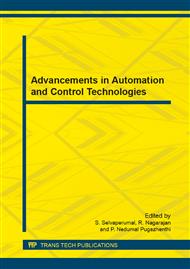[1]
B.P. McGrath and D. G. Holmes, Natural capacitor voltage balancing for a flying capacitor converter induction motor drive, IEEE Trans. Power Elect., vol. 24, no. 6, p.1554–1561, Jun. (2009).
DOI: 10.1109/tpel.2009.2016567
Google Scholar
[2]
W. Li and X. He, Review of non isolated high-step-up dc/dc converters in photovoltaic grid-connected applications, IEEE Trans. on Ind. Electronics, vol. 58, no. 4, pp.1239-1250, April (2011).
DOI: 10.1109/tie.2010.2049715
Google Scholar
[3]
Shahin, M. Hinaje, J. P. Martin, S. Pierfederici, S. Rael and B. Davat, High Voltage Ratio DC-DC Converter for Fuel-Cell applications, IEEE Trans. on Ind. Elect., vol. 57, pp.3944-3955, Dec. (2010).
DOI: 10.1109/tie.2010.2045996
Google Scholar
[4]
Bor-Ren Lin, Hsin-Hung Lu, A Novel PWM scheme for single-phase three-level power-factor-correction circuit, IEEE Trans. Ind. Electronics., Vol. 46, No. 2, Apr (2000).
DOI: 10.1109/41.836339
Google Scholar
[5]
S. C. Tan, Y.M. Lai, C. K. Tse, andM. K. H. Cheung, A fixed-frequency pulsewidth modulation based quasi-sliding-mode controller for buck converters, IEEE Trans. Power Electron., vol. 20, no. 6, p.1379–1392, Nov. (2005).
DOI: 10.1109/tpel.2005.857556
Google Scholar
[6]
V. B. Sriram, Sabyasachi SenGupta, and Amit Patra, Indirect Current Control of a Single-Phase Voltage-Sourced Boost-Type Bridge Converter Operated in the Rectifier Mode, IEEE Trans. Power Electron. vol. 18, no. 15, pp.1130-1137, Sep. (2003).
DOI: 10.1109/tpel.2003.816188
Google Scholar
[7]
O. Stihi and B. -T. Ooi, A single-phase controlled-current PWM rectifier, IEEE Trans. Power Electron., vol. 3, p.453–459, Oct. (1988).
DOI: 10.1109/63.17967
Google Scholar
[8]
Peter M. Barbosa, Francisco Canales, Jose M. Burdio and Fred C. Lee, A three-level converter and its application to power factor correction, IEEE Trans. Power Elect., vol. 20, no. 6, pp.1319-1327, Nov. (2005).
DOI: 10.1109/tpel.2005.857533
Google Scholar
[9]
S. -C. Tan, Y. M. Lai, C. K. Tse, L. Martinez-Salamero, and C. -K. Wu, A fast-response sliding-mode controller for boost-type converters with a wide range of operating conditions, IEEE Trans. Ind. Electron., vol. 54, no. 6, p.3276–3286, Dec. (2007).
DOI: 10.1109/tie.2007.905969
Google Scholar
[10]
Marcelo Pérez, Romeo Ortega, and José R. Espinoza Passivity-Based PI Control of Switched Power Converters, IEEE Trans. Power Electron., vol. 12, no. 6, p.881–890, Nov. (2004).
DOI: 10.1109/tcst.2004.833628
Google Scholar
[11]
Kanakasabai Viswanathan, Ramesh Oruganti and Dipti Srinivasan, Dual-Mode Control of Tri-State Boost Converter for Improved Performance, IEEE Trans. Ind. Elect., vol. 20, No. 4, July (2005).
DOI: 10.1109/tpel.2005.850907
Google Scholar
[12]
V. J. Sivanagappa, R. Ranjani, R. Suganya, K. Sumath, R. Yamuna Voltage control of ac-dc converter using sliding mode control, Emerging Technology and Advanced Engineering, ISSN 2250-2459 , vol. 3, Apr (2013).
Google Scholar
[13]
S. C. Tan, Y. M. Lai, and C. K. Tse, Indirect sliding mode control of power converters via double integral sliding surface, in IEEE Trans. Power Elect., vol. 23, no. 2, pp.600-611, Mar. (2008).
DOI: 10.1109/tpel.2007.915624
Google Scholar
[14]
Yu Chen and Yong Kang, The Variable-Bandwidth Hysteresis-Modulation Sliding-Mode Control for the PWM–PFM Converters, IEEE Trans. Power Elect., vol. 26, no. 10, p.2727–2734, Oct. (2011).
DOI: 10.1109/tpel.2011.2158852
Google Scholar
[15]
Benoit Labbe, Bruno Allard, Xuefang Lin-Shi, and David Chesneau An integrated sliding-mode buck converter with switching frequency control for battery-powered applications, IEEE Trans. Power Electron., vol. 28, no. 9, p.4318–4326, Sep. (2013).
DOI: 10.1109/tpel.2012.2226754
Google Scholar
[16]
Enric Vidal-Idiarte, Carlos E. Carrejo, Javier Calvente and Luis Martínez- Salamero, Two-Loop Digital Sliding Mode Control of DC–DC Power Converters Based on Predictive Interpolation, IEEE Trans on Ind. Electron., vol. 58, No. 6, June (2011).
DOI: 10.1109/tie.2010.2069071
Google Scholar


